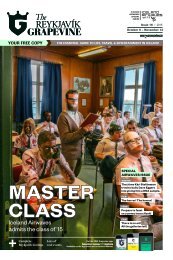101rvk
101rvk
101rvk
You also want an ePaper? Increase the reach of your titles
YUMPU automatically turns print PDFs into web optimized ePapers that Google loves.
The Reykjavík Grapevine Issue 6 — 2013<br />
Vera is one of the editors of an Icelandic web magazine called Lemúrinn (Icelandic for the native primate of<br />
Madagascar). A winner of the 2012 Icelandic Web Awards, Lemurinn.is covers all things strange and interesting!<br />
Go check it out at www.lemurinn.is.<br />
38<br />
The Icelandic Tourist Experience In 1925<br />
Words by Vera Illugadóttir<br />
In July 1925, a German cruise ship called the SS München stopped<br />
in Reykjavík, its first stop on a month-long trip to the wild north,<br />
including subsequent stops in Jan Mayen, Svalbard and the north<br />
of Norway before returning to Germany in August.<br />
Iceland’s tourism industry had not really taken off in 1925. A<br />
cruise ship landing in Reykjavík was rare enough that newspapers<br />
reported detailed information about the ship, its passengers—<br />
about 400 people—and their itinerary during their stay in Iceland.<br />
They stayed in Iceland for two days, spending their first day<br />
at Þingvellir, where they listened to a lecture about the ancient<br />
Alþingi, and their second day in Reykjavík, where they enjoyed the<br />
capital’s rich cultural life including a wrestling match and a performance<br />
by a female choir wearing national costumes.<br />
According to an article in the newspaper Vísir, the passengers<br />
included “members of the German Friends of Iceland society, including<br />
the director of the society’s new Berlin division, the merchant<br />
herr Emil Deckert.” Also on board was the photographer<br />
Richard Fleischhut, who took the photos that appear here.<br />
The newspaper urged its readers to treat the foreigners with<br />
“the utmost kindness and friendliness.”<br />
The Germans coming ashore at the Reykjavík harbour.<br />
This almost post-apocalyptic scene is actually our<br />
German tourists exiting the museum of sculptor Einar<br />
Jónsson on Skólavörðuholt, the hill in the city centre<br />
where Hallgrímskirkja now stands. The museum, which<br />
opened in 1923, is the first art museum in Iceland.<br />
A female choir dressed in Iceland’s national costume<br />
performing onboard the SS München.<br />
It is a sad modern development that exhibition matches<br />
in Icelandic glíma wrestling are no longer held, especially<br />
for tourists. The German tourists sat in the front<br />
row for this match staged at Reykjavík’s central square<br />
Austurvöllur.<br />
The Germans in Þingvellir, a must-see site for tourists<br />
in 1925 as in 2013.<br />
Traditional Icelandic turf dwellings slowly disappeared<br />
during the first half of the twentieth century, but here<br />
we see an example from Reykjavík, still inhabited.<br />
Preparing one of Iceland’s main exports, dried salted cod.<br />
The hot spring in Laugardalur, where generations of<br />
Reykjavík’s citizens did their laundry until the 1930s when<br />
the city got its first hot-water supply. Laugardalur is now<br />
better known for its swimming pool and sports arena.<br />
The Green Choice<br />
Premium Quality Vegetarian Food<br />
• Vegetarian dishes<br />
• Vegan dishes<br />
• Bakes and soups<br />
• Wholesome cakes<br />
• Raw food deserts<br />
• Coffee and tea<br />
Grænn Kostur is the perfect downtown choice<br />
when you are looking for wholesome great tasting meals.<br />
Grænn Kostur | Skólavördustíg 8b<br />
101 Reykjavík | Sími: 552 2028<br />
www.graennkostur.is<br />
Opening hours:<br />
Mon - Sat. 11:30 - 21:00<br />
Sun. 13:00 - 21:00<br />
1.680 kr.<br />
Vegetarian Dish of the Day



